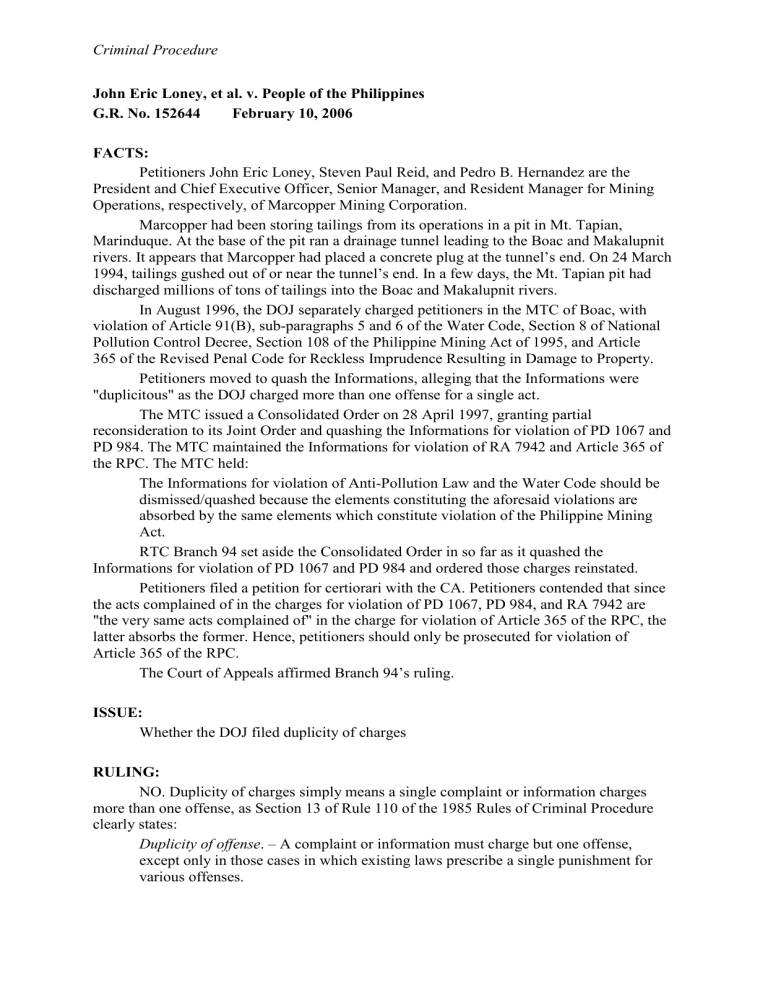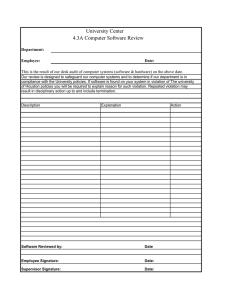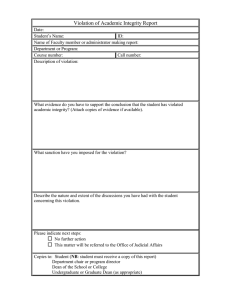
Criminal Procedure John Eric Loney, et al. v. People of the Philippines G.R. No. 152644 February 10, 2006 FACTS: Petitioners John Eric Loney, Steven Paul Reid, and Pedro B. Hernandez are the President and Chief Executive Officer, Senior Manager, and Resident Manager for Mining Operations, respectively, of Marcopper Mining Corporation. Marcopper had been storing tailings from its operations in a pit in Mt. Tapian, Marinduque. At the base of the pit ran a drainage tunnel leading to the Boac and Makalupnit rivers. It appears that Marcopper had placed a concrete plug at the tunnel’s end. On 24 March 1994, tailings gushed out of or near the tunnel’s end. In a few days, the Mt. Tapian pit had discharged millions of tons of tailings into the Boac and Makalupnit rivers. In August 1996, the DOJ separately charged petitioners in the MTC of Boac, with violation of Article 91(B), sub-paragraphs 5 and 6 of the Water Code, Section 8 of National Pollution Control Decree, Section 108 of the Philippine Mining Act of 1995, and Article 365 of the Revised Penal Code for Reckless Imprudence Resulting in Damage to Property. Petitioners moved to quash the Informations, alleging that the Informations were "duplicitous" as the DOJ charged more than one offense for a single act. The MTC issued a Consolidated Order on 28 April 1997, granting partial reconsideration to its Joint Order and quashing the Informations for violation of PD 1067 and PD 984. The MTC maintained the Informations for violation of RA 7942 and Article 365 of the RPC. The MTC held: The Informations for violation of Anti-Pollution Law and the Water Code should be dismissed/quashed because the elements constituting the aforesaid violations are absorbed by the same elements which constitute violation of the Philippine Mining Act. RTC Branch 94 set aside the Consolidated Order in so far as it quashed the Informations for violation of PD 1067 and PD 984 and ordered those charges reinstated. Petitioners filed a petition for certiorari with the CA. Petitioners contended that since the acts complained of in the charges for violation of PD 1067, PD 984, and RA 7942 are "the very same acts complained of" in the charge for violation of Article 365 of the RPC, the latter absorbs the former. Hence, petitioners should only be prosecuted for violation of Article 365 of the RPC. The Court of Appeals affirmed Branch 94’s ruling. ISSUE: Whether the DOJ filed duplicity of charges RULING: NO. Duplicity of charges simply means a single complaint or information charges more than one offense, as Section 13 of Rule 110 of the 1985 Rules of Criminal Procedure clearly states: Duplicity of offense. – A complaint or information must charge but one offense, except only in those cases in which existing laws prescribe a single punishment for various offenses. Criminal Procedure In short, there is duplicity (or multiplicity) of charges when a single Information charges more than one offense. Under Section 3(e), Rule 117 of the 1985 Rules of Criminal Procedure, duplicity of offenses in a single information is a ground to quash the Information. The Rules prohibit the filing of such Information to avoid confusing the accused in preparing his defense. Here, however, the prosecution charged each petitioner with four offenses, with each Information charging only one offense. Thus, petitioners erroneously invoke duplicity of charges as a ground to quash the Informations. On this score alone, the petition deserves outright denial. Petitioners contend that they should be charged with one offense only — Reckless Imprudence Resulting in Damage to Property — because (1) all the charges filed against them "proceed from and are based on a single act or incident of polluting the Boac and Makalupnit rivers thru dumping of mine tailings" and (2) the charge for violation of Article 365 of the RPC "absorbs" the other charges since the element of "lack of necessary or adequate protection, negligence, recklessness and imprudence" is common among them. As early as the start of the last century, this Court had ruled that a single act or incident might offend against two or more entirely distinct and unrelated provisions of law thus justifying the prosecution of the accused for more than one offense.24 The only limit to this rule is the Constitutional prohibition that no person shall be twice put in jeopardy of punishment for "the same offense." In Water Code, the additional element to be established is the dumping of mine tailings into the Makulapnit River and the entire Boac River System without prior permit. In Anti-Pollution Law, the existence of actual pollution must be proved. In Philippine Mining Act, the additional fact that must be established is the willful violation and gross neglect on the part of the accused to abide by the terms and conditions of the Environmental Compliance Certificate, particularly that the Marcopper should ensure the containment of run-off and silt materials from reaching the Mogpog and Boac Rivers. On the other hand, the additional element that must be established in Art. 365 of the Revised Penal Code is the lack of necessary or adequate precaution, negligence, recklessness and imprudence on the part of the accused to prevent damage to property. Moreover, the offenses punished by special law are mal[a] prohibita in contrast with those punished by the Revised Penal Code which are mala in se. Consequently, the filing of the multiple charges against petitioners, although based on the same incident, is consistent with settled doctrine.



